I show what great observations are possible when a balcony is designed to be close to nature. I want to make you want to create opportunities for birds. To make the balcony look interesting from a bird’s point of view, to pay them a first visit. If they then find seeds on the wild plants or sunflowers, for example, there is bird food available and they feel safe, they will be happy to return regularly.
Lots of birds visit my balcony. So far, 24 bird species have visited my two inner-city balconies in Berlin (4 m² + 5 m²). That is a large number. The fact that there is a chestnut tree in front of my balcony is certainly an advantage. Also, an extension of the Wilmersdorf public park is only 200 m away. Garden owners have written to me saying that they are nowhere near this number. But I know of many other inner-city balconies with over 15 recorded bird species. We have a lot of birds in our cities. If we observe them from our balconies, we invite them to join us.
I show what great observations are possible when a balcony is designed close to nature, supplemented with food for the birds. I want to make you want to create something for the birds on your balcony. To make the balcony look interesting and inviting from a bird’s point of view, to pay them a first visit. If they then find seeds on the wild plants or sunflowers, for example, and put down food, and if they also feel safe, they will come back. We can watch from behind the window. Or even better, sitting directly on the balcony. I love sitting on my beautiful reddish-brown wooden bench and above me the sparrows are playing around at the feeders or looking for seeds in the balcony boxes. The tits are just as busy. It’s a real treat for me. It brings me relaxation. We’re doing something good for ourselves and the birdlife too.
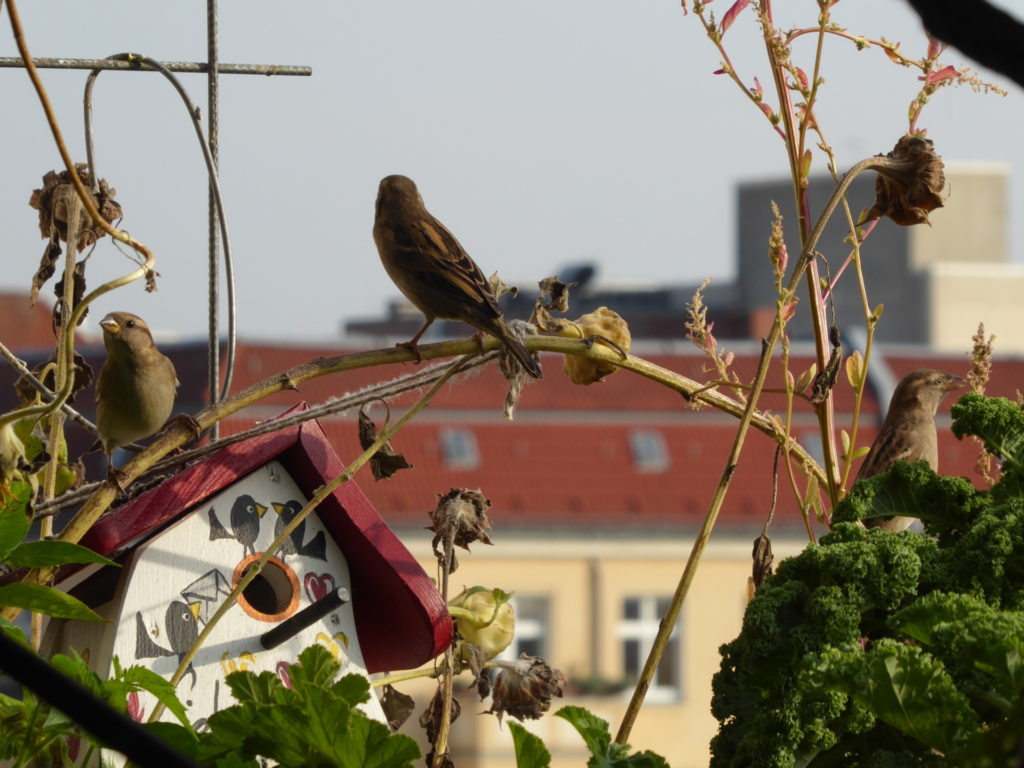

Birds love branches sticking out or up from the balcony, sticks sticking out from the balcony railing, branches stuck in planters or branches tied to the railing with cable ties. They can make a stopover there and then fly to the feeding sites. My son built a so-called “Rumschibumschi” in an art project at school. Art made from branches joined together. The name alone is so beautiful, and then there are the works of art. The children collected branches, bark and seeds. They put their treasures together: glued or tied or nailed them. They really had a lot of fun. We mounted the “Rumschibumschi” on a corner of the balcony parapet. Securely tied several times with cable ties. The birds love to land right there on the “Rumschibumschi”. So this art project has been well received and appreciated. I invite you to make your own personal “Rumschibumschis” and also Insect nesting aids. The most beautiful observations are possible. Throughout the year. Throughout the year.


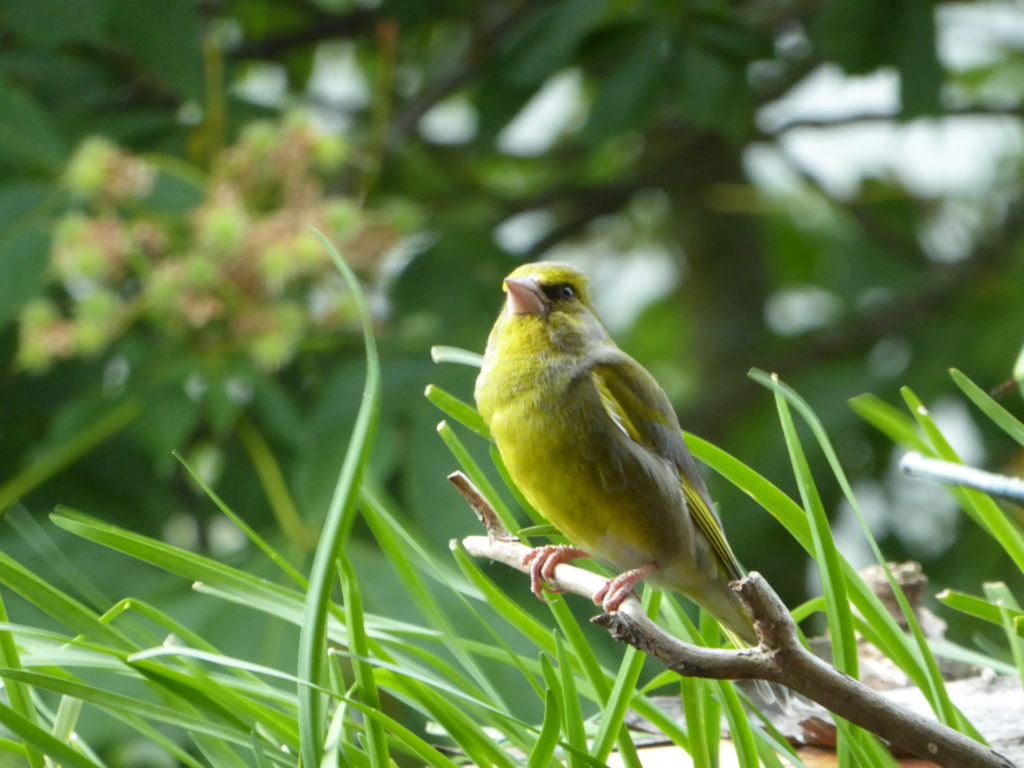

The birds love trees on the balcony and shrubs. They love sitting on my five Columnar apple trees or the bee tree. On the snack balcony I have a corner with fruit trees: chokeberries, rock pears, blackberries, Chinese berries and raspberries. The house sparrows love to sit in there. They can chatter there. If I open the door from the balcony or bathroom, there is a commotion and all the birds fly away immediately. Plant trees!



Withered, dried out plants are left standing. The birds love to land there, looking for the seeds e.g. of sunflowers, tree spinach ‘Magenta Spreen’. Wonderful observations. However, they still like to land there to fly to the feeding sites. These are regular stopovers. There are also large sticks or bamboo poles in several balcony boxes, where the tits like to land. I pull tomatoes and beautifully flowering sweet potatoes up to the ceiling on strings. Once they have dried out, the birds like to land on them in winter. From there they fly to the feeders or make a tour of the balcony boxes for insects or fallen food.
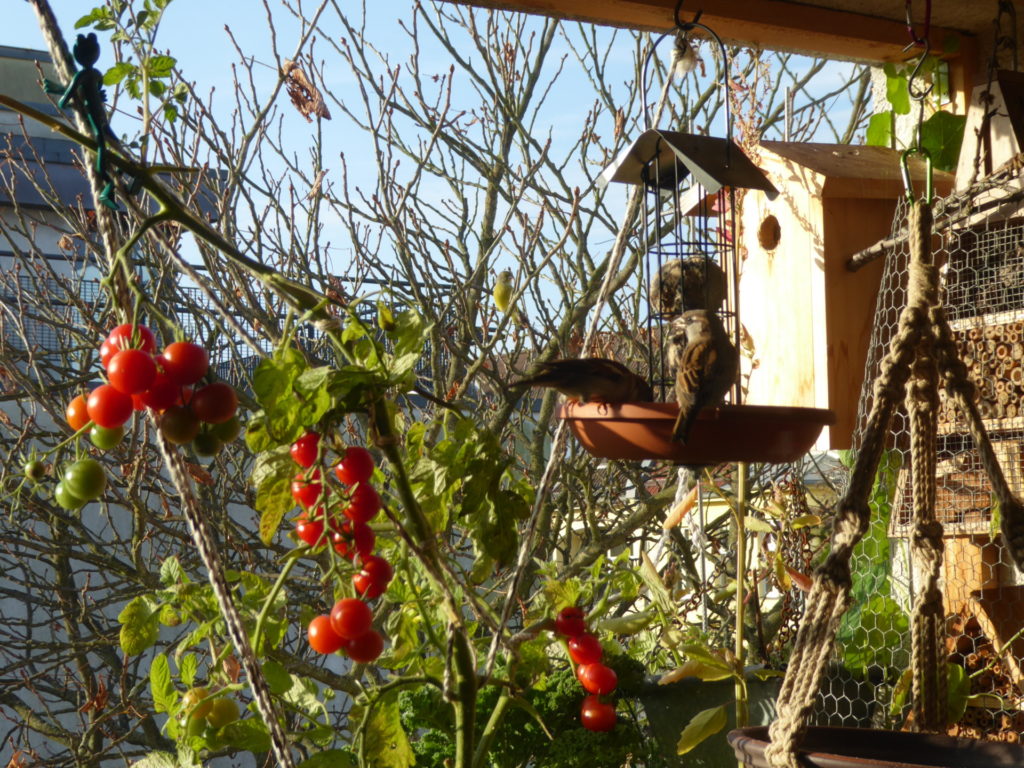

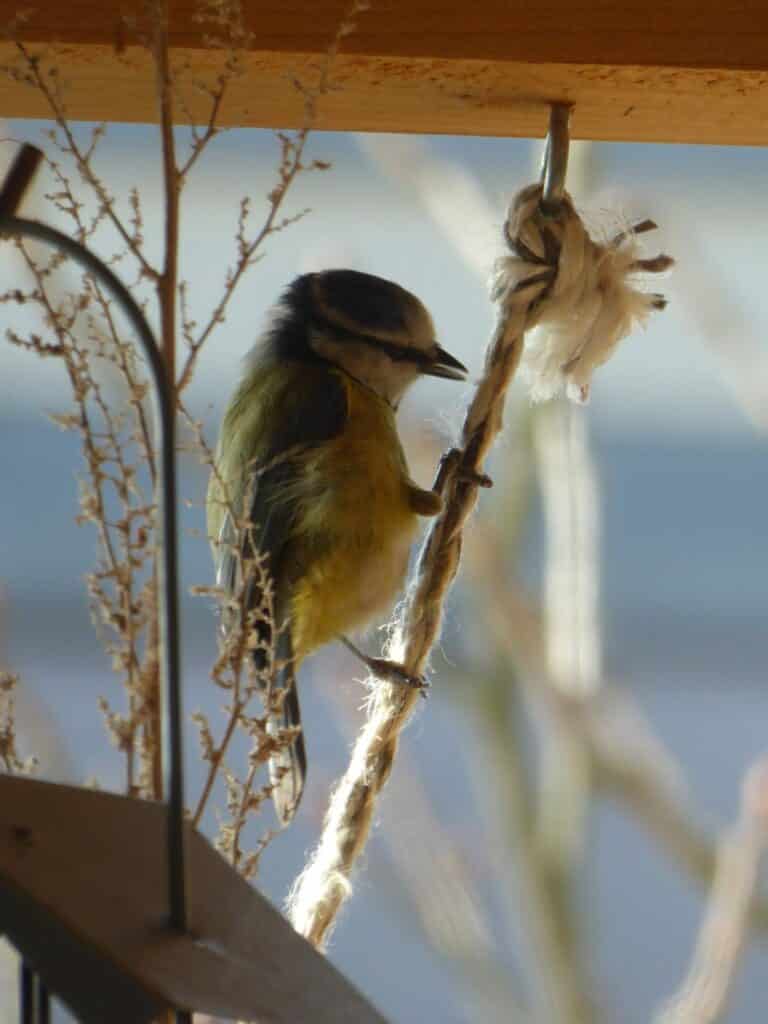
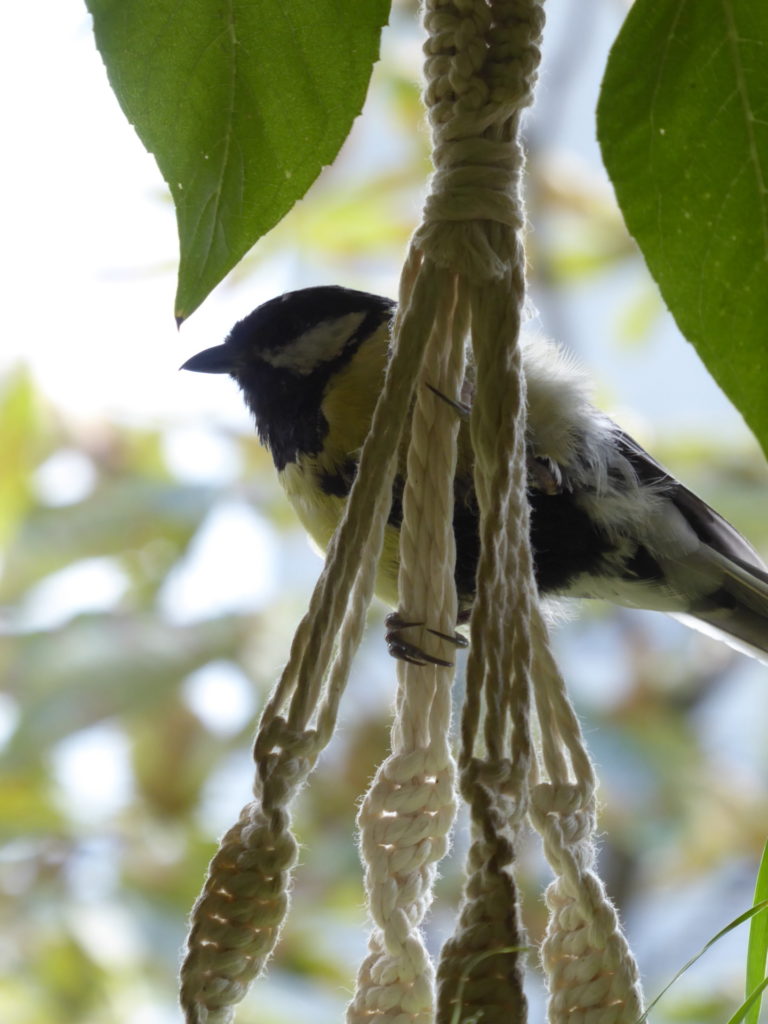
Feeding stations with shelled sunflower seeds hang from my ceiling. There is also a dispenser with peanuts, the extremely popular tit dumplings and coconut halves filled with fat food. There are sparrows, greenfinches, blue tits and great tits up there, and the great spotted woodpecker was there more often. I have set up another feeding station on my bench with shelled sunflower seeds and peanut butter, which is very popular with the blackbirds, starlings and black redstarts. The plate of oatmeal and raisins on the floor is frequented by blackbirds, starlings and robins. A treecreeper often scurries around on the floor, and I have even seen two at the same time. There is also a Water trough. The squirrels often drink there. The water trough hanging from the ceiling was not accepted by the birds. Not even when it was on the bench. I haven’t yet found a place where the birds feel safe. I will keep trying.
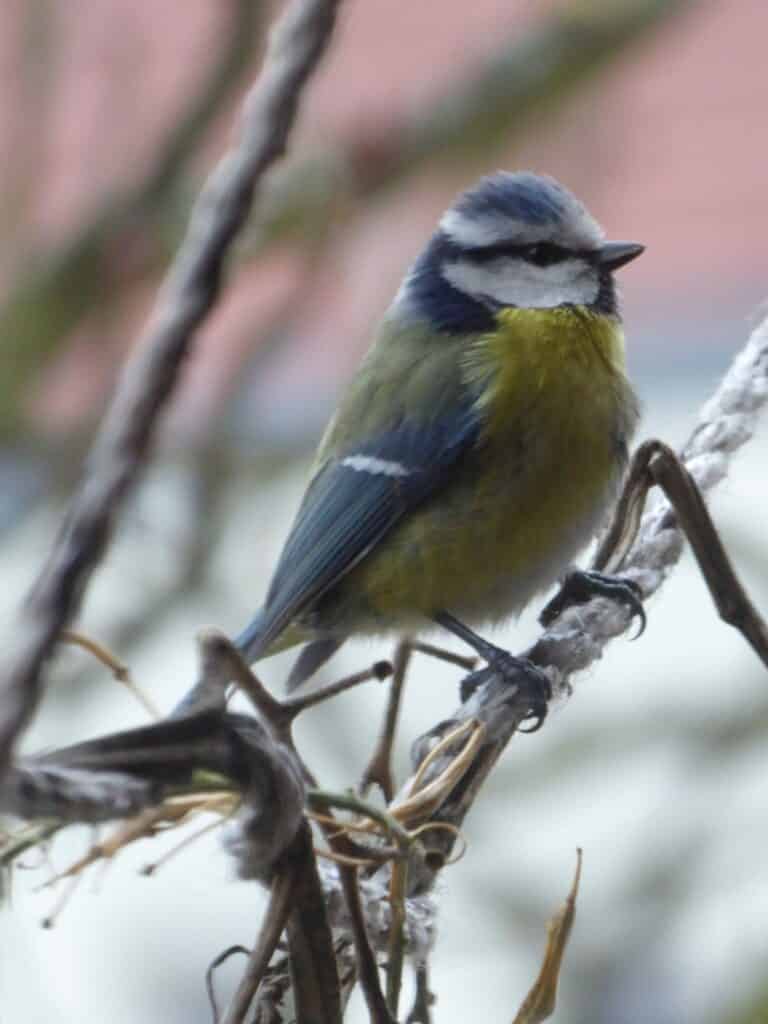
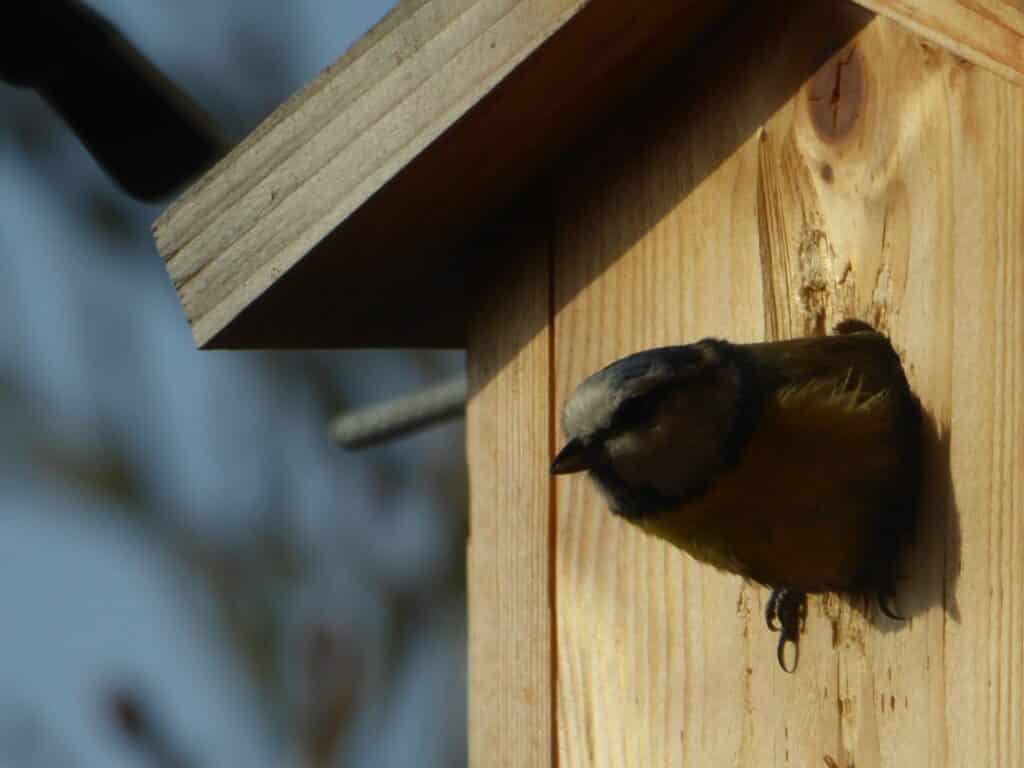
The dense vegetation on the balcony probably “protects” against pigeons. The winter before last, I had a lot of pigeons on the balcony. I let them snack briefly, then I shooed them away because my tenancy agreement contains a ban on feeding pigeons. In most big cities, there is a ban on feeding pigeons, with no distinction between urban pigeons and wild pigeons. We city dwellers should be aware of this ban. This winter the pigeons are again sitting on the parapet of the house opposite and directly in front of the balcony in the chestnut tree. The balcony is completely uninteresting for them, probably because of the dense vegetation.

These were my measures to get nice bird visits. The birds poop around, of course, which is not so nice on the balcony. There is food lying around, they are not yet so well behaved. Since I’ve been using unpeeled sunflower seeds, there’s less lying around. The blackbirds are having a terrible time digging around in the planters. They are looking for the tasty earthworms that work for me. The many bird visitors are therefore somewhat at odds with the cultivation of vegetables, I don’t want to hide that. This dichotomy can occur. I think it’s worth being able to watch the birds from such a close distance. It gives me a huge sense of relaxation. As well as a huge joy, which I am so happy to share with you.
High-quality bird feeders, nesting boxes and accessories — recommended by NABU and LBV
You can get high-quality food, nesting boxes, accessories and plants from the full-service provider Vivara nature conservation products. This store is recommended by NABU and LBV.

Book recommendation
For me, this is the best book on the subject by Prof. Peter Berthold and his wife Gabriele Mohr:

I conducted an interview with Prof. Berthold for the Online Organic Balcony Congress 2017: What is the ideal bird food? Tit dumplings.
What tips do you have for bird watching and feeding on the balcony? Are you or have you perhaps also been in a dilemma between bird feeding and self-sufficiency, because both are not ideal at the same time?
I have been asked to provide more “evidence” that the tree spinach ‘Magenta Spreen’ is indeed used as a naturally grown food source by house sparrows and goldfinches. Don’t cut anything down in the fall, don’t fall into the “tidying and tidying madness”. Our shrubs, stems and fallen leaves are wintering grounds for insects. Birds pick out the seeds. Here even on the windowsill on the 6th floor in Berlin-City. Garden casually — it’s good for us and the city animals. Best wishes to the hard-working gardeners from the Charno community garden.







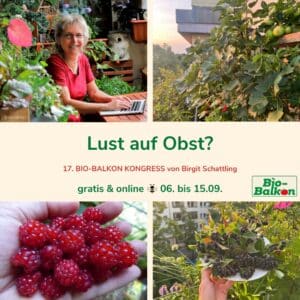


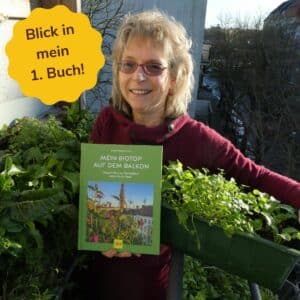

16 Responses
Have a nice day,
I got the link to your site from a friend (journalist for a country life magazine). I read your blog with great pleasure at the beautiful pictures.
I have been feeding garden birds all year round for a few years now — but I live “in the village”. Nevertheless, I make very similar observations to yours.
I am writing to you because I happen to have your “book tip” at home. Like you, I am impressed by the author’s in-depth knowledge. For a long time I had a guilty conscience because I also feed in the warm season — I thought it was too cute. The book now says that it is even urgently necessary to feed birds all year round.
That reassured me at the same time, but also made me sad. Because the reason is, of course, thought-provoking.
In any case, I have now dealt extensively with the subject of year-round feeding and will definitely continue to practice it.
My tip for beginners: Be sure to set up/plant cover near the feeding place where the small birds can hide if danger threatens. They are reluctant to visit free-standing feeders.
I hope you continue to enjoy your little paradise
Kerstin
Dear Judith, thank you for your fine comment. Year-round bird feeding has such a bad image in Germany due to lobbying by German nature conservation associations. A change is slowly taking place. Anyone who feeds birds all year round will soon realize that the birds eat much more in spring/summer during the breeding season. The feeders can be constantly replenished. The energy requirements of birds are clearly higher, as Prof. Dr. Peter Berthold explains. Thank you for pointing out the opportunities for cover in the feeding area. That is correct. Wonderful observations to you too, have a magical season, best wishes Birgit
Very interesting report. When I was in the UK/Scotland I noticed that in some regions the birds are fed all year round and I have been doing it ever since.
Have fun Judith
Dear Judith, I also practice year-round bird feeding. This means I can watch the most amazing birds on my inner-city balcony in Berlin all year round. It’s so much fun. Only the Germans find it difficult to feed birds all year round, whereas in England it is common practice. I conducted an interview with Prof. Dr. Peter Bertold, the long-time director of the Radolfzell Ornithological Institute, for the Online Organic Balcony Congress. You can read an excerpt here: https://bio-balkon.de/was-ist-das-ideale-vogelfutter-meisenknoedel/. Together with his wife, he wrote the classic book “Vögel füttern, aber richtig: Das ganze Jahr füttern, schützen und sicher bestimmen” and is an advocate of year-round bird feeding. A very important book for me. Best wishes and wonderful observations to you too Birgit
Dear Birgit!
I attended your balcony congress this spring and then bought the package because it contained so many valuable tips for non-balcony owners, including about feeding birds all year round. Professor Bertold really inspired me and was an eye-opener. Yes, and now I feed the birds diligently and sometimes I feel like they are eating the hair off my head, I can hardly keep up. Instead, they chirp, chirp and chirp, sometimes screeching all around the garden, which is a real joy. I think Kerstin’s tip about the cover is really great. I did it quite unintentionally because the feeders are under trees and high bushes, which is where the small birds prefer to go. Incidentally, a great spotted woodpecker is also a frequent guest. Unfortunately, I don’t have a bed or table from which I can watch the birds, I prefer to let them feed undisturbed in the overgrown front garden and usually stay in the back garden. Nevertheless, I found it so incredibly beautiful during the interview in the kitchen garden congress, how the little birds were cavorting at the feeders during the conversation and how there is so much life on this tiny balcony spot! Best wishes from the far north of Austria, Luzia
Dear Luzia, you give me such valuable feedback. Thank you very much. I am so pleased that you have been so inspired. That you feed the birds. That you get just as much pleasure out of it as I do. Your birds are also so hungry. “My” birds eat the hair off my head too. They are so hungry. All the young birds are in the groups. There’s a lot going on. They always have to be replenished. There will be another bird expert at the next congress. But Prof. Dr. Berthold sets the standard. I really like him. Best wishes to the far north of Austria, Birgit
I think it’s great what you’ve done with your balcony! I came across your website by chance and it’s great what’s going on on your balcony. Regarding the many birds that have a lively rendezvous on your balcony: haven’t any neighbors complained about it yet? I also tried bird-friendly plants and food but got into a lot of trouble with the property management, who even gave me a warning. I stopped feeding and planted bee- and insect-friendly herbs and plants instead. What does your property management think about all the animals on your balcony, which I think is great! Keep up the good work! Best regards from Charlottenburg, Manuela
Dear Manuela, thank you for your comment. Now I have to be careful what I write, it’s public. Feeding inside the balcony is allowed. We are allowed to offer whatever we want inside the balcony. Only the pigeons have a special role. We have to check whether we have a ban on feeding pigeons in the rental agreement or whether our city has issued such a ban. We should adhere to this and take appropriate measures when pigeons come. We must not cause a nuisance to neighbors by using the balcony. The principle of neighborly consideration applies. For me, run-off water was a problem. The number of my plants, the trees and the pots were discussed in the disputes. I called in a lawyer and spoke to the property management and explained my position. There are neighbors who feel disturbed by the falling leaves. I talk to them and explain that I want more nature in the city. I want my son to grow up with a connection to nature, to know how and when our native wild plants and, above all, useful plants grow, how our native animals live. This is important to me. I also hand out tomatoes and flowers, but I stick to my point of view. I’m helpful within the house, that’s the right thing to do anyway. I had an agreement with the previous property management company. Unfortunately, we’ve been sold and there’s a new property management company. I’m going to make an appointment to speak to them soon to position myself. I know that property managers are quick to issue warnings and make things easy for themselves. We tenants have rights and we should exercise them. We shouldn’t make ourselves look small. But we should always keep our neighbors in mind. As always, a compromise must be found that everyone involved can live with. Feeding within the balcony. Kind regards Birgit
Hello everyone, perhaps there could be a solution like mine. I feed all year round in the green planting on the playground in front of my balcony and can now watch the birds wonderfully from the balcony. I can also see straight away when they need refilling. The birds also feel very safe in the wild roses. So I don’t have the problem with the roommates in the house and have brought the birds to my balcony anyway. I have an agreement with the employees of the building yard, who cut back the bushes, that they will leave the feeders hanging.
Unfortunately, the pigeons have (almost) completely spoiled my desire to feed the birds on the balcony. I hope I can get rid of them again. The only thing I can think of that I could hang up to feed them are tit rings, but the pigeons probably won’t go near them. Food silos are also out of the question, as food always falls down and the pigeons eat it. Any other ideas for getting rid of pigeons and how I could offer food for the other birds in a pigeon-safe way?
And thank you very much for the natural balcony inspiration! I have copied a lot 🙂
I understand the problem. When it comes to pigeons, we should always bear in mind that pigeon feeding bans have been introduced in many cities. Or that the tenancy agreement contains a ban on feeding pigeons. Try the tit rings. Maybe you can also offer a feeder with a (handmade) wire frame/wire basket around it. The wire must be of such dimensions that the pigeon’s head cannot get through. I have also seen bars being pulled into an existing feeder so that the pigeon could not get in/through, but the small birds could. Perhaps a short break from feeding will help them to find their bearings and you can start again after a while. Thank you for your comment and feedback, keep up the good work, have fun!
According to my tenancy agreement, there is also a ban on feeding pigeons, but I would probably have tried to get rid of them regardless of the agreement. Although they are nice to look at from a certain distance, I don’t want them on my own balcony. For this reason, I need the help of pigeon control professionals to get rid of all the birds on my roof.
wow… such beautiful pictures. I started feeding on my balcony 3 weeks ago and have put out various feeders. The bird house is spurned, but a hanging wire basket is popular with the robins and the same wire basket on the balcony railing is popular with the blackbirds. Otherwise I haven’t had any visitors yet. In spring I would like to plant the balcony with native plants/shrubs and hope that the birds will also feel more comfortable with some covering greenery. Which plants can you recommend for a balcony of approx. 3 x 4m? About 5 flower boxes and a few more pots are planned.
Dear Liliane, it’s great that you’ve started to spruce up your balcony and make it animal-friendly. As an organic balcony, I really like it. It takes a while for the birds to find your feeder. They have fixed flight paths that they follow (several times) every day. They first have to “discover” you. In my experience, fixed sticks or branches help — stuck into the planters or attached to the parapet so that they protrude upwards and forwards over the parapet. However, you should keep an eye on the neighbors when they are overhanging. They will rightly feel annoyed if they get bird droppings. Test out how the birds and the neighbors behave. My 9th Online Organic Balcony Congress “Can you plant animals?” starts on March 18. https://bio-balkon.de/kann-man-tiere-pflanzen‑2/is a free online event with over 30 expert interviews. There you can get lots of planting recommendations for native plants and woody plants, as these are also important for birds. There are also four interviews on birds. To read up — with planting recommendations — why not pick up the new booklet from the Nature Garden Association “Naturbalkon und Topfgarten” (Nature balcony and pot garden) https://shop.naturgarten.org/natur-garten/227/natur-garten‑1/2022-naturnahe-balkone-und-topfgaerten?c=16. That’s great. If you also want to harvest something and encourage animals, I recommend my book “Mein Biotop auf dem Balkon. Experience nature and harvest happiness in the middle of the city” https://bio-balkon.de/buch/ or my online course https://bio-balkon.de/onlinekurs-starterguide/. I have a natural balcony and harvest a lot. Both are important to me — you can see it in my pictures. Kind regards Birgit
Thank you very much… I will take a look and look forward to spring so that I can plant 🙂
Hermann-Josef asks: Listen, is there any trick to keeping the neighbors calm? I answer: Objective, appreciative communication that responds to objections, remain firm on the matter. We need nature, we are nature!